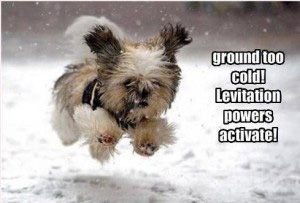I admit that winter is not my season. I am what my kids call a “temperature wuss”.
My husky, on the other hand, thinks there is nothing better than bounding through the snow! Winter is a fun-land for her, where every chunk of snow becomes a ball to play with.
So how can a Winter Wonderland be rough on doggy toes?
Road Salt
We are all familiar with that white haze that coats our cars and boots. Salt can keep the sidewalks passable, but it is not a friend to feet. Salt sucks all the moisture out of tissues, leading to irritation of the skin between the toes, and cracking of the pads.
So what to do?
The best protection are booties to cover the paws. Soft fleece booties with a non-slip bottom are often tolerated better than stiff nylon or canvas booties.
If your dog positively will not put up with footwear, take these steps:
Before going outside:
- Trim any excess hair that sticks out between the toes on the underside of the paw – this is where iceballs form!
 Apply a barrier layer to the underside of the paw: there is a “chapstick” for dog paws called Paw Guard, or you can use vaseline*. Some people even use cooking spray. Do not use anything that is not safe for them to swallow when they lick their feet (eg Bag Balm). *Don’t use vaseline if there is any actual open wound on your dog’s paw – it interferes with the growth of new skin cells to cover the wound)
Apply a barrier layer to the underside of the paw: there is a “chapstick” for dog paws called Paw Guard, or you can use vaseline*. Some people even use cooking spray. Do not use anything that is not safe for them to swallow when they lick their feet (eg Bag Balm). *Don’t use vaseline if there is any actual open wound on your dog’s paw – it interferes with the growth of new skin cells to cover the wound)
When you come back in:
- Rinse off his paws – a footbath bowl kept by the door with some towels work best.
- Be sure to remove any chunks of ice stuck between your dog’s paws.
Frost Bite
Vigourous activity keeps warm blood from the body moving through the paws. Frostbite happens when the cold is too extreme for the body’s warmth to keep up (this can happen in ear tips, as they are so thin), or when the body is running out of heat due to hypothermia.
Frost nip is where the blood vessels are all spasmed up from the cold; the tissues are pale, but circulation can be restored with gentle warming. The area will get pretty red (and sore!) when the blood comes back in.
Frost bite, on the other hand, is where the tissue has actually frozen. Cells burst open when the water within them crystallizes. At this point, the tissues are dead. Frost bite does not really hurt until circulation returns to the tissues next to it, and the body starts reacting against the dead tissue. Frost bitten tissues are a greyish colour, with a margin of red inflamed tissue next to it.
If you suspect cold damage to your dog’s paws, ears or tail (you will not know if it is frost nip or frost bite until you see if the blood supply returns as it warms):
- Warm them gently; towels warmed in the dryer are a good idea, or water that is just luke-warm.
- Don’t rub! Rubbing could cause the cold tissue to split apart from the warm.
- Then get to the vet! A dog with hypothermia may need warmed IV fluids, and possibly a stomach tube to wash in/drain out warm water – we want to warm the body core first and foremost. If there is blood vessel spasm in the chilled areas, there are medications that can help open the blood vessels up. And of course, we want to address pain control!
So, enjoy getting out there in these cold months with your dog! Just watch that you don’t let winter become a Pain In The Paws!


